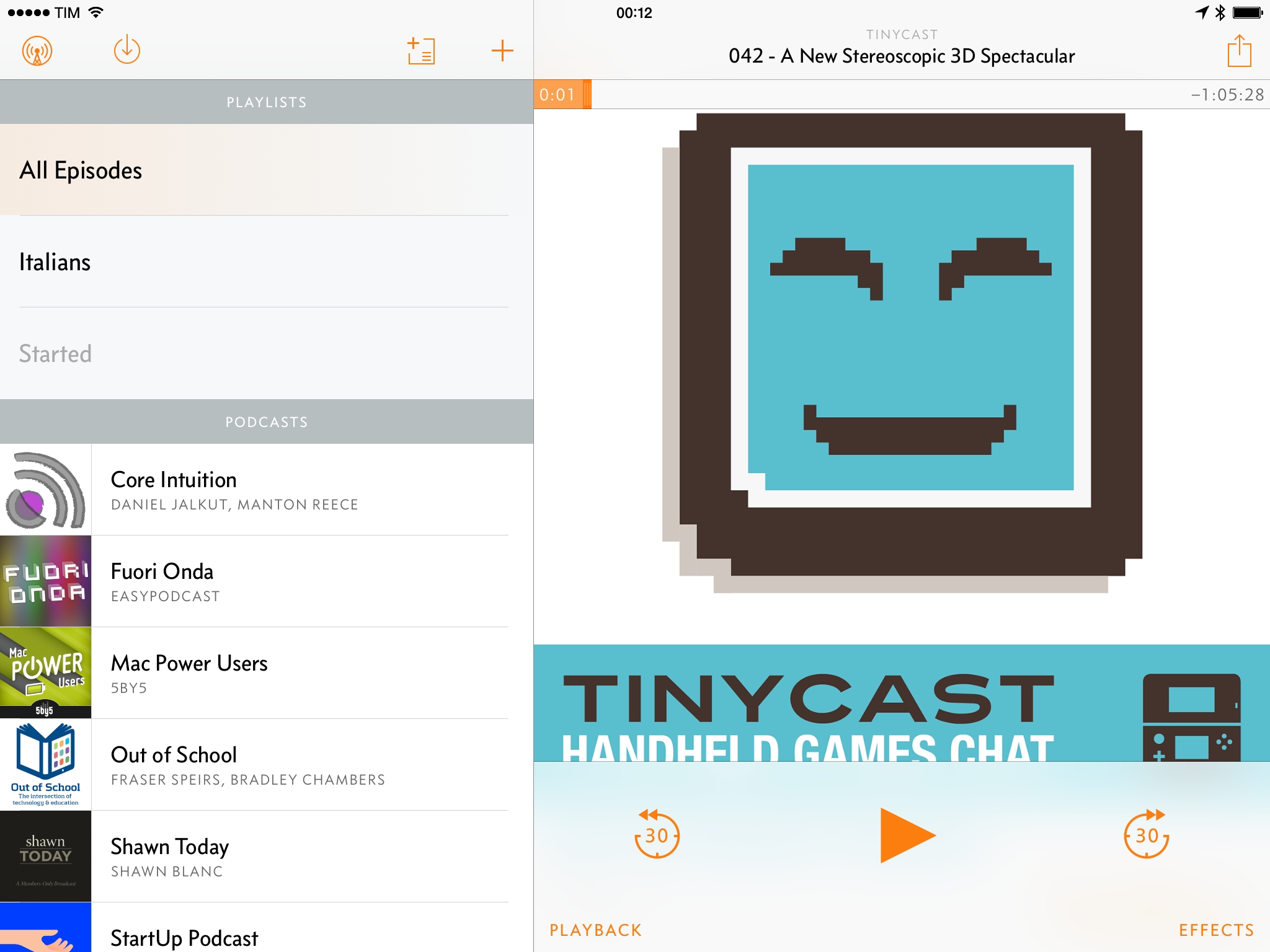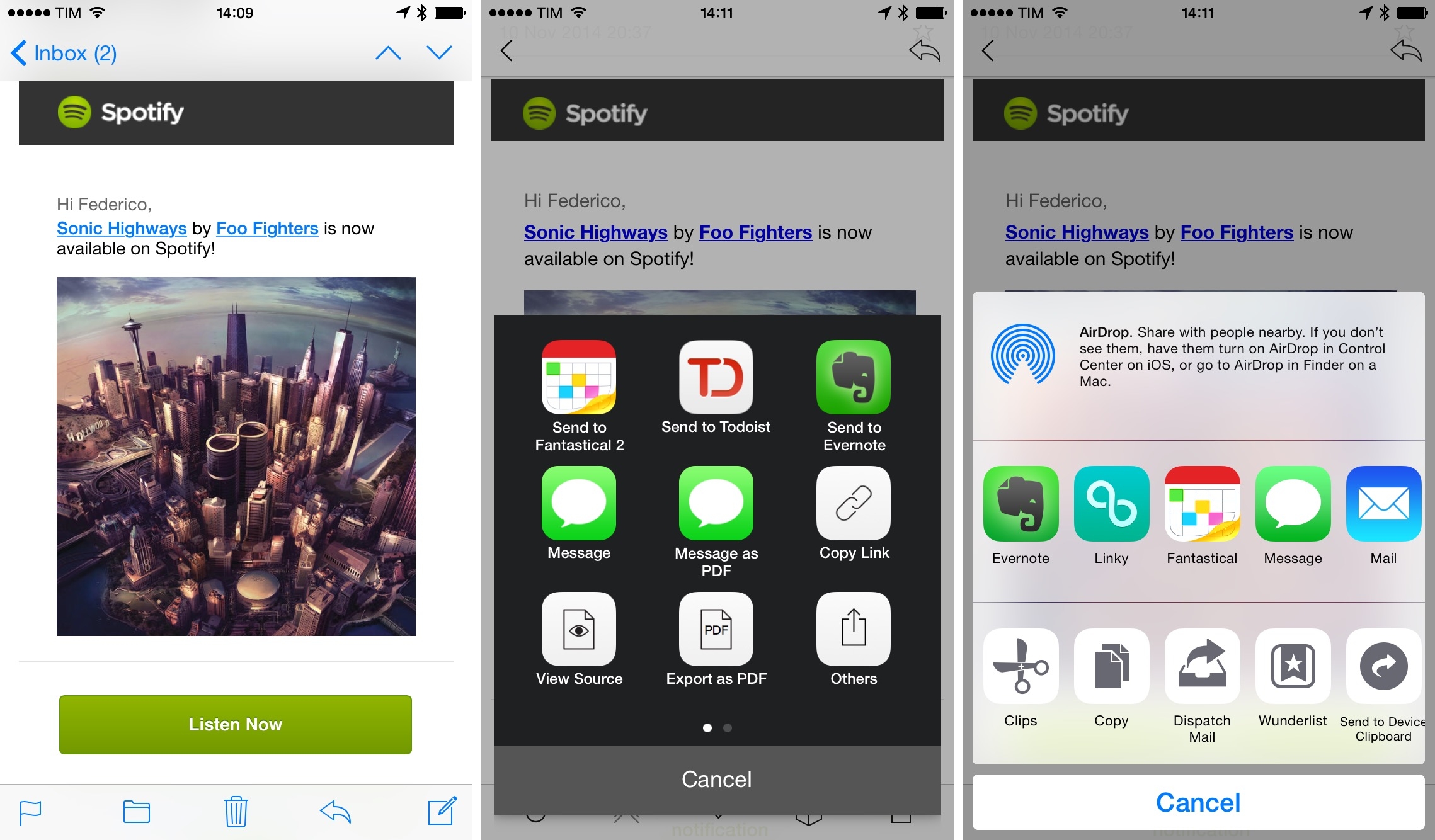Overcast, Marco Arment’s excellent podcast player that I reviewed back in July and that became my favorite way to listen to podcasts on the iPhone, has been updated today to version 1.1. The new version, which I’ve been testing on my iPad Air 2 and iPhone 6 for the past couple of weeks, brings a welcome iPad interface, further optimizations for iOS 8 with bug fixes, and a new landscape mode on the iPhone.
Overcast 1.1 Brings iPad App, New Landscape Mode
iOS 8, Email, and Extensions
One of my biggest frustrations with iOS 8 so far is the lack of extension support in Apple’s Mail app. As I wrote in iOS 8 Changed How I Work on My iPhone and iPad:
I’m disappointed to see a lack of extension support in Apple’s own apps, and particurlarly in Mail. It just makes sense, in my opinion, to be able to turn messages into tasks or archived documents, but Apple hasn’t integrated extensions with Mail yet.
My feelings haven’t changed since September and, in fact, Mail’s non-existent sharing capabilities have been exacerbated by my move towards a more iPad-centric workflow after upgrading to an iPad Air 2. I’ve been working from my iPad Air 2 on a daily basis for the past two weeks, and the friction in Apple’s Mail app has led me to use other email clients simply because they came up with their own implementation of action and share extensions for email messages.
Automatic: Your Smart Driving Assistant on Your Smart Phone [Sponsor]
There’s a mountain of data inside your car waiting to be unleashed, and all you have to do is plug in a quick little connector and download a mobile application.
Automatic is a smart driving assistant that plugs into your car’s data port and lets you connect your smartphone (either iPhone or Android) with your car. By talking to your car’s onboard computer and using your smartphone’s GPS and data plan to upgrade your car’s capabilities, Automatic will allow you to easily diagnose your engine light, never forget where you parked your car, and save hundreds of dollars on gas.
Automatic learns your driving habits and gives you suggestions through subtle audio cues to drive smarter and stop wasting gas. Thanks to a map view available on your phone, Automatic can display a trip timeline after every driving session, showing you how you’re doing with a Drive Score; the app can even track local gas prices and tell you how much you’re spending.
In case of engine problems, Automatic can decipher what the “check engine” light means and show you a description of the issue with a possible solution. And thanks to a feature called Crash Alert, Automatic can detect many types of serious crashes and automatically alert local authorities as well as your loved ones when you can’t.
Automatic is currently available in the US for iPhone and Android devices, with a 45-day return policy and free shipping in 2 business days. Automatic retails at $99.95 with no subscription fees.
MacStories readers can go to automatic.com/macstories to get $20 off and buy Automatic at just $79.95. For more information, check out Automatic’s website.
Our thanks to Automatic for sponsoring MacStories this week.
Integrating iThoughtsX with Marked 2→
Brett Terpstra writes about the new integration of Marked 2 with iThoughtsX:
iThoughtsX is currently my favorite mind mapping tool on OS X. Marked 2 is, obviously, my favorite way to preview Markdown. Now they work together. You can simply drag an iThoughtsX map file to Marked, and it will start previewing an outline of your map as you work. Every time you save your map in iThoughts, you’ll see the changes in the resulting Markdown document, previewed in whatever theme you’re working with.
As you can see in the video above, the integration is seamless: every change you make in a mind map is reflected in the Markdown preview of Marked.
Both iThoughts and Marked are excellent pieces of software. I miss the ubiquitous preview capabilities of Marked on iOS, but, fortunately, iThoughts developer Craig Scott worked out a pretty sweet integration with Editorial.
Virtual: Lost in a Glass of Water→
This week Myke and Federico talk about what Nintendo is doing with Amiibo and the Quality of Life strategy, Fantasy Life and Sunset Overdrive.
On this week’s Virtual, the game that is slowly consuming my free time and a discussion on Nintendo’s curious plan for their Quality of Life initiative. Get the episode here.
Sponsored by:
Monument Valley “Forgotten Shores” Expansion Launching Next Week→
Monument Valley, one of my favorite iOS games of 2014, will receive its first expansion next week. Titled “Forgotten Shores” and priced at $1.99 as an In-App Purchase, the expansion will add 8 new levels to Monument Valley and further explore the story of Ida and Totem.
Liz Stinson writes at Wired:
Monument Valley was designed as a complete story; the 10 levels formed a beginning, middle and end. When you closed the app for the final time, there was closure. But people didn’t want closure. They wanted more Monument Valley. Its designers were torn: They wanted to add more levels, mostly because people were asking for them. But they felt Monument Valley ended on a high note–1.4 million downloads, to be exact. “It was never 100 percent settled on that we were going to create more content for Monument Valley,” says Gray. “It’s very much a self contained experience. So the question was, how do we create something that doesn’t disrupt that?”
ustwo made a beautiful and poetic game with the original Monument Valley, and I can’t wait to get my hands on the expansion pack. You can read my original review of the game here.
Connected: Come Grocery Shopping With Me→
This week Federico and Myke talk a little about photo storage solutions, before discussing the widgets in their Today Views, what’s on Federico’s iPad home screen and his impressions of the iPad Air 2.
Following the Home screen episode for iPhone, we couldn’t avoid mentioning widgets. Myke also wanted to know about my iPad Home screen. You can find the episode with detailed show notes (including links to apps and images) here.
Sponsored by:
Different Share Sheets
Alvaro Serrano makes a great point about share sheets and extensions in apps updated for iOS 8:
With Reeder’s iOS 8 update, this means Reeder users now have two different ways to send an article to Instapaper: they can use the app’s built-in Instapaper integration, or they can use the Instapaper Extension via the Share Sheet. This looks redundant, but there’s a catch.
In order to use the Instapaper Extension, the Instapaper app must be installed on the device. But what happens if you don’t want to have Instapaper on that particular device? What if, for instance, you browse through your RSS feeds on your iPhone but only read articles on your iPad? In order to do that using Extensions, you’d need to have Instapaper installed on both devices. Using Reeder’s built-in Instapaper integration, however, you’d only need to have it installed on the iPad, which is where you’re actually going to use it.
He uses the latest Reeder as an example, but the same is also true for Unread, Dispatch, and other apps that used to have custom sharing options before iOS 8.
For developers, there are several trade-offs involved with keeping old sharing options and implementing Apple’s new action and share extensions. Do you want to handle user credentials for web services like Instapaper and Pocket, bundling a custom sharing menu that you have to manage? That would also give you more control over the entire sharing feature – for instance, users may be able to activate the service anywhere and not just from a share sheet. As an example, think of how Tweetbot could show read-later options before the iOS 8 update.
On the other hand, extensions free you, as a developer, from the burden of asking users to enter their credentials, designing a login flow, implementing error checking, or creating a UI for each supported option. You just need to support the system share sheet and pray that it’ll work. And, obviously, iOS 8 extensions will give you all the benefits of a unified system: they’re secure, they have an interface designed by their own developer, and they work consistently with other apps.
For now, I don’t think pre-iOS 8 share sheets with hard-coded options will be going away. But as the extension system matures and developers start releasing new apps for iOS 8, I believe that the need for custom sharing options will naturally decrease, letting native extensions take over and benefiting users and developers.
Expectations for WatchKit→
David Smith has been reading through Apple’s WatchKit documentation, and he believes that full apps for the Apple Watch will likely arrive at WWDC next year:
Next June at WWDC I then expect we will receive the tools necessary to build out more fully capable applications. Just like we have seen with iOS I’d guess this will be a progressive expansion of capability with each successive year. Just as early iPhone OS apps were severely constrained to save battery life, we’ll probably see strict limits on what types of apps we can build initially. We are essentially resetting the battery life equation with this new device. So no background processing or multitasking for a while (with the possible exception of music/audio playback).
According to recent speculation, the Apple Watch may be released in the Spring.
Back in 2010, a lot of developers struggled to create iPad apps between January and April without an actual iPad, so limiting WatchKit to notifications and glanceable information is probably the best strategy for now.




